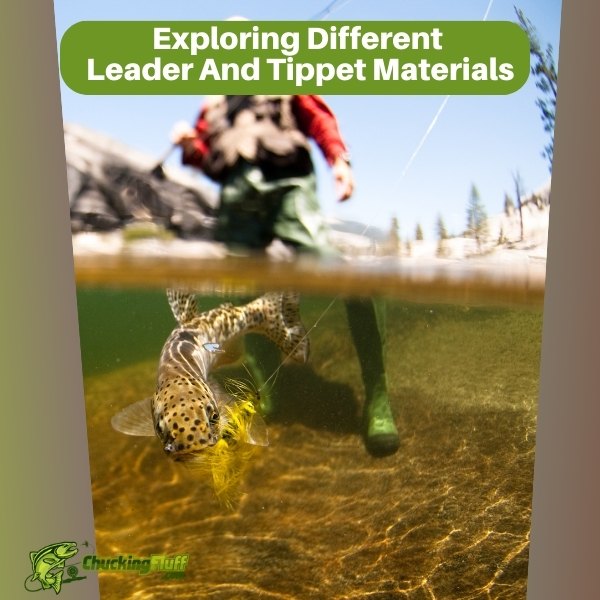| Disclosure: Just to be open and honest the buttons and links you click on in the website will in most cases take you to another website where you can purchase the products I am reviewing. As an Amazon Associate I earn from qualifying purchases. |
Exploring Different Leader And Tippet Materials

Fly fishing is a pursuit of finesse and deception. We strive to present our artificial flies in a way that convinces even the wariest fish that they’re the real deal. And in this intricate dance of deception, our leader and tippet materials play a crucial role. They are the invisible threads that connect us to our quarry, and choosing the right material can make all the difference between a successful day on the water and an empty creel.
Quick Post Navigation
The Fundamentals of Leaders and Tippets
Before we delve into the world of leader and tippet materials, let’s revisit why these seemingly simple strands are so vital to our fly fishing success.
Why We Need Leaders and Tippets
Imagine trying to cast a tiny, weightless fly with just your fly line. It’d be like throwing a feather with a rope – not very effective, right? That’s where leaders and tippets come in. They act as a crucial transition between your thick fly line and your delicate fly, allowing for a smooth transfer of energy during your cast and a natural presentation in the water.
The Tapered Design: A Gradual Transition
Leaders are typically tapered, meaning they gradually decrease in diameter from the butt section (which connects to your fly line) to the tippet end. This taper is essential for efficient energy transfer during your cast, allowing you to lay your fly down gently on the water’s surface.
Monofilament: The Classic Choice
Monofilament has been the go-to leader and tippet material for generations of fly anglers. It’s a single strand of nylon, and it’s known for its versatility and affordability.
Pros of Monofilament
Suppleness and Knot Strength
Monofilament is relatively supple, meaning it’s flexible and allows your fly to move naturally in the water. It also ties well, forming strong knots with relative ease.
Affordability and Availability
Monofilament is readily available and generally less expensive than other leader and tippet materials. This makes it a great option for anglers on a budget.
Cons of Monofilament
Visibility and Stretch
Compared to fluorocarbon, monofilament is more visible underwater. It also has more stretch, which can make it harder to detect subtle takes and set the hook effectively.
Susceptibility to Abrasion
Monofilament is prone to abrasion, meaning it can be weakened or damaged by rubbing against rocks, logs, or even the teeth of fish.
Fluorocarbon: The Stealthy Contender
Fluorocarbon is a relatively new player in the fly fishing world, but it has quickly gained popularity due to its unique properties. It’s a fluoropolymer, and its refractive index is closer to that of water, making it nearly invisible.
Pros of Fluorocarbon
Near Invisibility Underwater
Fluorocarbon’s low visibility makes it a fantastic choice for spooky fish in clear water. It’s like having an invisible thread connecting you to your fly.
Faster Sink Rate and Abrasion Resistance
Fluorocarbon is denser than monofilament, so it sinks faster. This is beneficial when fishing nymphs or streamers. It’s also more resistant to abrasion, making it a good choice for fishing in rocky or snag-filled environments.
Cons of Fluorocarbon
Stiffness and Knot Sensitivity
Fluorocarbon is generally stiffer than monofilament, which can affect the natural movement of your fly. It’s also more sensitive to knot-tying errors, requiring careful attention to detail.
Higher Cost
Fluorocarbon is typically more expensive than monofilament. However, its unique properties often justify the added cost, especially for demanding fishing situations.
Copolymer: Blending the Best of Both Worlds
Copolymer lines are designed to combine the best attributes of both monofilament and fluorocarbon.
A Marriage of Materials
Copolymer lines typically consist of a nylon core (for suppleness and knot strength) with a fluorocarbon coating (for reduced visibility and abrasion resistance). This combination aims to provide a balanced performance.
Applications of Copolymer
Copolymer lines can be a good all-around choice for various fishing situations. They offer a compromise between the stealth of fluorocarbon and the affordability and ease of use of monofilament.
Specialty Materials: Exploring Niche Options
While monofilament, fluorocarbon, and copolymer cover most fly fishing scenarios, there are also specialty materials for specific needs.
Braided Leaders: For Delicate Presentations
Braided leaders are constructed from multiple strands of material woven together. They are incredibly supple and help deliver your fly with exceptional delicacy, making them ideal for dry fly fishing in calm conditions.
Wire Tippet: Taming Toothy Critters
When targeting fish with sharp teeth, like pike or musky, wire tippet is a must. It provides the necessary strength and abrasion resistance to prevent bite-offs.
Choosing the Right Material: Factors to Consider
With so many options available, how do you choose the right leader and tippet material for your needs? Here are some key factors to consider:
Target Species and Fishing Environment
The type of fish you’re targeting and the environment you’re fishing in will influence your choice. For spooky trout in clear water, fluorocarbon might be the best bet. For bass in murky water, monofilament could suffice.
Fly Size and Presentation
The size and type of fly you’re using will also play a role. Delicate dry flies often benefit from fine tippets and supple materials, while heavy streamers might require stronger, stiffer tippets.
Personal Preference
Ultimately, the best leader and tippet material is the one that you feel most confident using. Experiment with different options and see what works best for your fishing style and preferences.
Conclusion
Choosing the right leader and tippet material is a crucial step in maximizing your fly fishing success. By understanding the properties of different materials and considering your specific needs, you can make informed decisions that will help you present your flies effectively and fool even the most discerning fish. So, embrace the variety, experiment with different options, and discover the perfect combination for your next fly fishing adventure!
FAQs
1. Can I use a fluorocarbon leader with a monofilament tippet?
Yes, you can use a fluorocarbon leader with a monofilament tippet, and vice versa. However, it’s generally recommended to use the same material for both for optimal performance.
2. What is the best leader and tippet material for saltwater fly fishing?
Fluorocarbon is often preferred for saltwater fly fishing due to its abrasion resistance and low visibility in clear saltwater environments.
3. How do I store my leaders and tippets to keep them in good condition?
Store your leaders and tippets in a cool, dark place away from direct sunlight. Avoid storing them in humid environments or where they might be exposed to chemicals.
4. What is the difference between a “hard” and “soft” monofilament?
“Hard” monofilament is stiffer and more abrasion-resistant, while “soft” monofilament is more supple and has more stretch.
5. Can I reuse my leader and tippet?
While you can technically reuse your leader and tippet, it’s generally recommended to replace them regularly, especially after catching a fish or fishing in abrasive environments.


